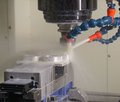Difference between revisions of "Virtual designs into physical objects/Intro"
From AdCiv
| Line 1: | Line 1: | ||
| − | [[Image:CNC pic.jpg|120px|right]] At some point virtual designs such as [[Computer-aided design|CAD]] models, need to be turned into physical objects, which unfortunately isn't as straightforward as downloading software from a website. Building, testing and modifying physical designs requires effort, time and material cost, although with access to emerging flexible computer-controlled manufacturing techniques this complexity and effort can be drastically reduced. | + | [[Image:CNC pic.jpg|120px|right]] At some point virtual designs such as [[Computer-aided design|CAD]] models, need to be turned into physical objects, which unfortunately isn't as straightforward as downloading software from a website. Building, testing and modifying physical designs requires effort, time and material cost, although with access to emerging flexible computer-controlled manufacturing techniques this complexity and effort can be drastically reduced. We are entering the age of digital manufacturing. |
<p> | <p> | ||
Some of the ways that collaborative designs created on a computer can be physically forged range from getting your hands dirty and crafting it yourself, to sending the design, or at least parts of it, as an electronic file to an increasing number of computer-controlled manufacturing systems such as [[rapid prototyping machines|rapid prototyping]] or advanced multi-axis {{wp|CNC|CNC machines}} that can accurately create parts in 3D in a variety of materials. What is illustrated in this section is that the world of atoms is starting to catch up with the world of bits in terms of ease of control and duplication. Here are some of the increasing number of methods available to bring virtual designs to life... | Some of the ways that collaborative designs created on a computer can be physically forged range from getting your hands dirty and crafting it yourself, to sending the design, or at least parts of it, as an electronic file to an increasing number of computer-controlled manufacturing systems such as [[rapid prototyping machines|rapid prototyping]] or advanced multi-axis {{wp|CNC|CNC machines}} that can accurately create parts in 3D in a variety of materials. What is illustrated in this section is that the world of atoms is starting to catch up with the world of bits in terms of ease of control and duplication. Here are some of the increasing number of methods available to bring virtual designs to life... | ||
Revision as of 11:44, 30 December 2009
At some point virtual designs such as CAD models, need to be turned into physical objects, which unfortunately isn't as straightforward as downloading software from a website. Building, testing and modifying physical designs requires effort, time and material cost, although with access to emerging flexible computer-controlled manufacturing techniques this complexity and effort can be drastically reduced. We are entering the age of digital manufacturing.
Some of the ways that collaborative designs created on a computer can be physically forged range from getting your hands dirty and crafting it yourself, to sending the design, or at least parts of it, as an electronic file to an increasing number of computer-controlled manufacturing systems such as rapid prototyping or advanced multi-axis CNC machines  that can accurately create parts in 3D in a variety of materials. What is illustrated in this section is that the world of atoms is starting to catch up with the world of bits in terms of ease of control and duplication. Here are some of the increasing number of methods available to bring virtual designs to life...
that can accurately create parts in 3D in a variety of materials. What is illustrated in this section is that the world of atoms is starting to catch up with the world of bits in terms of ease of control and duplication. Here are some of the increasing number of methods available to bring virtual designs to life...
